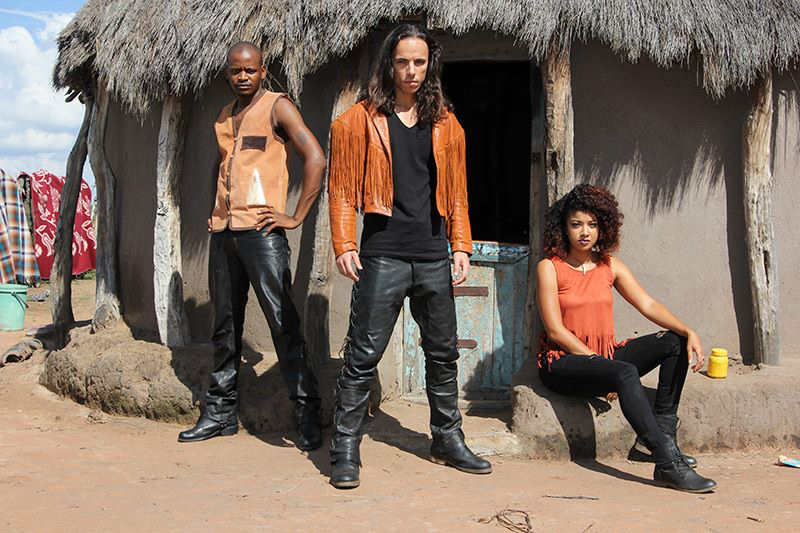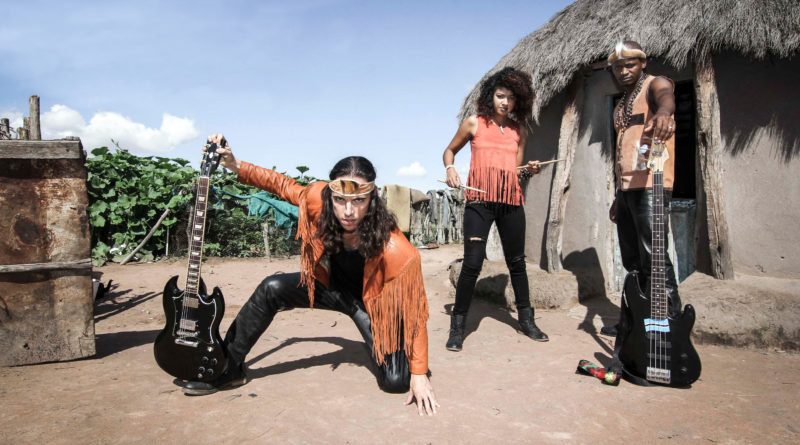The Heavy Side of Africa: A Conversation with Skinflint’s Giuseppe Sbrana
Skinflint founder and guitarist/vocalist Giuseppe Sbrana wants the world to know one thing: heavy metal can be found in all corners of the globe — Africa included.
Sbrana, along with bassist Kebonye Nkoloso and drummer Alessandra Sbrana have generated five albums and E.P.s from their Botswana, Africa locale, including their latest and strongest effort, the self-titled album released in June. Combining elements of African culture with straight forward, raw heavy metal, the trio has has managed to turn some heads in the metal community. And as the interest rises, so does their ability to preach the gospel of African metal.
ListenIowa caught up with Sbrana recently to to discuss the local metal scene, the importance of staying true to their cultural roots, and the future of Skinflint.
What does music scene in Botswana, Africa look like?
Botswana has a small but dedicated following of leather-clad metalheads. The scene here is raw and unique in its expression. The fans are very passionate and there is a strong sense of brotherhood. Musically, it leans more towards old school metal, and its underground.
Is there a sense of Westernization at all?
There is definitely a strong Western influence in the metal scene here, but that is not necessarily a bad thing. I think it becomes a problem only if the scene loses its identity, which fortunately is not the case here in Botswana. I think it is an interesting combination to mix elements from Western music with African culture.
Being a metal band from Africa must have its advantages and disadvantages. From a positive standpoint, do you think the “unique” nature of heavy metal even emanating from Africa is helpful to Skinflint?
Certainly. It gives us the opportunity to play heavy metal from a different perspective, experimenting and breathing new life into the genre by incorporating African influences.
On the other side of the coin, what are some of the barriers you’ve run into because of this?
The majority of the youth here are ignorant of the metal scene, and listen to house, R&B and other commercial music. In many ways, Metal is not seen as a music for local bands, and most of the media, DJs, and promoters are not willing to work with our style of music. We have to play in difficult conditions and set up everything ourselves.
What’s the big misconception about heavy metal from Africa?
That it is something recent. Rock/metal has been around Africa for many years. It is only since the Internet became popular that people started to become aware of bands here.
Sepultura did something unique with their “Roots” record in giving the world a glimpse of Brazil, South America by incorporating the culture into the song and album. Skinflint does the same here, and even more. Why such an emphasis on the cultural aspect your music?
Growing up in Botswana storytelling, superstitions and myths were in abundance. These tales greatly interested me, and would later find their way into the music of Skinflint. This gave us new topics to explore and also inspired the music to take a direction more fitting to the atmosphere generated by these tales. As a band, we worked hard together to capture the essence of what makes these myths special and create a sound for it that is metal but at the same time distinctively African.
What was your first introduction to heavy music, and at what point did you say to yourself, “This is what I want to try to make a living doing.”
My late uncle, Ray Sbrana, was an excellent blues guitarist, and he borrowed me some of his Jimi Hendrix tapes and various other blues artists. After listening to Hendrix for the first time, I knew I wanted to become a guitarist and music became my passion. I started out as a blues guitarist when I was 12 years old and later in my late teens I discovered the album “Paranoid” by Black Sabbath, and that was my introduction to heavymetal music.
How did the band initially form?
I founded Skinflint back in 2006 in the sweltering countryside of a small village called Mokolodi, in Botswana. I used to jam with my cousin, Alessandra Sbrana, who plays drums, and later met Kebonye Nkoloso at a Rock Festival in Lobatse. The chemistry was great, and we knew we had something special.
Creatively, where do your musical influences come from?
The songs are inspired by African Culture and rhythms. Musically, there is also a strong emphasis on the blues, as well as bands such as Jimi Hendrix, Black Sabbath and Iron Maiden.
I can hear the Iron Maiden-ish vibe at times, except yours comes with a doom element to it.
I do feel like the doom elements are more prominent in this album.
Some say Skinflint is responsible for the term “African metal.” How does it feel to be considered an innovator?
It feels risky, and at times you will be misunderstood, and even ridiculed. But it is worth it, and we will stay true to our vision.
The band has been together for more than a decade now, and has five full-length albums under its belt. Your latest album shows a maturity in terms of quality, song writing, playing.
Thank you. After many years of playing music you start to discover elements that make your sound unique, and I think in this album you can hear a band that is not afraid to push those elements to the forefront. I feel it has a very distinctive tone, which is unmistakably Skinflint and showcases our vision for African metal. We wanted the songs to happen naturally and not feel like it was planned. We wrote the majority of the album in a week, which is unusual for us, but I think this approach gave the songs a feeling of spontaneity. We took a similar approach to the recording process. It is not overproduced and retains the raw energy and passion of a band live in the studio. I think the result is an album that sounds honest and sincere, rather than striving for perfection.
Your “Birds and Milk, Bloody Milk” video is strong conceptually.The song is inspired by an African tale of a bird who tells a man to kill his only milk cow, and in turn the bird will bring him 100 more cows. In desperate conditions, the man complies, but the bird does not keep its end of the agreement. We used dancers in the video as the song is a fusion of Kwasa Kwasa, a type of dance music that is popular here in Africa with heavy metal. We used a cow skull emerging from a bowl of milk to signify the “Bloody Milk.”
Speaking of dripping, “The Hyena Sorcerer” has some distinct old Black Sabbath tones.
Glad you like it, as it is one of my favorites. The song is about a half-man, half-heyna creature said to have magical powers that summon the dead.
What do you see the future holding for Skinflint?
We hope to tour the world and play to metal fans as well as expand on our style of heavy metal.
For more information on Skinflint, visit:
https://www.skinflintmetal.com/
www.facebook.com/SKINFLINTMETAL
twitter.com/skinflintmetal


